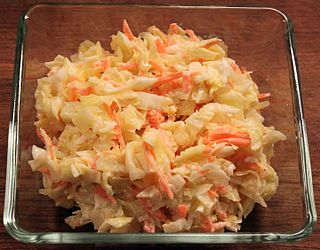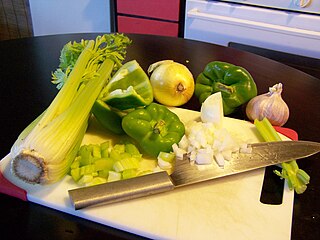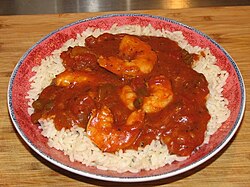
Cajun cuisine is a style of cooking developed by the Cajun–Acadians who were deported from Acadia to Louisiana during the 18th century and who incorporated West African, French and Spanish cooking techniques into their original cuisine.

Tomato sauce can refer to many different sauces made primarily from tomatoes, usually to be served as part of a dish, rather than as a condiment. Tomato sauces are common for meat and vegetables, but they are perhaps best known as bases for sauces for Mexican salsas and Italian pasta dishes. Tomatoes have a rich flavor, high water content, soft flesh which breaks down easily, and the right composition to thicken into a sauce when stewed without the need for thickeners such as roux or masa. All of these qualities make them ideal for simple and appealing sauces.

Ceviche, cebiche, sebiche, or seviche is a dish consisting of fish or shellfish marinated in citrus and seasonings, recognized by UNESCO as an expression of Peruvian traditional cuisine and Intangible Cultural Heritage of Humanity, although different versions of ceviche are part of the culinary culture of various Spanish-American countries along the Pacific Ocean where each one is native: Chile, Colombia, Costa Rica, Ecuador, El Salvador, Guatemala, Honduras, Mexico, Nicaragua, Panama and Peru. In Peru it is also considered a flagship dish and cultural heritage.

Louisiana Creole cuisine is a style of cooking originating in Louisiana, United States, which blends West African, French, Spanish, and Native American influences, as well as influences from the general cuisine of the Southern United States.

A mirepoix is a mixture of diced vegetables cooked with fat for a long time on low heat without coloring or browning. The ingredients are not sautéed or otherwise hard-cooked, because the intention is to sweeten rather than caramelize them. Mirepoix is a long-standing part of French cuisine and is the flavor base for a wide variety of dishes, including stocks, soups, stews, and sauces.

Gumbo is a stew that is popular in the U.S. state of Louisiana, and is the official state cuisine. Gumbo consists primarily of a strongly flavored stock, meat or shellfish, a thickener, and the Creole "holy trinity" – celery, bell peppers, and onions. Gumbo is often categorized by the type of thickener used, whether okra or filé powder.

Jambalaya is a savory rice dish of mixed origins that developed in the U.S. state of Louisiana apparently with African, Spanish, and French influences, consisting mainly of meat or seafood, and vegetables mixed with rice and spices.

Scallions are edible vegetables of various species in the genus Allium. Scallions generally have a milder taste than most onions. Their close relatives include garlic, shallots, leeks, chives, and Chinese onions.

Fried rice is a dish of cooked rice that has been stir-fried in a wok or a frying pan and is usually mixed with other ingredients such as eggs, vegetables, seafood, or meat. It is often eaten by itself or as an accompaniment to another dish. Fried rice is a popular component of East Asian, Southeast Asian and certain South Asian cuisines, as well as a staple national dish of Indonesia. As a homemade dish, fried rice is typically made with ingredients left over from other dishes, leading to countless variations. Fried rice first developed during the Sui Dynasty in China.

Coleslaw, also known as cole slaw, or simply as slaw, is a side dish consisting primarily of finely shredded raw cabbage with a salad dressing or condiment, commonly either vinaigrette or mayonnaise. This dish originated in the Netherlands in the 18th century. Coleslaw prepared with vinaigrette may benefit from the long lifespan granted by pickling.

The "holy trinity" in Cajun cuisine and Louisiana Creole cuisine is the base for several dishes in the regional cuisines of Louisiana and consists of onions, bell peppers and celery. The preparation of Cajun/Creole dishes such as crawfish étouffée, gumbo, and jambalaya all start from this base.

Sofrito, sofregit, soffritto, or refogado is a basic preparation in Mediterranean, Latin American, Spanish, Italian and Portuguese cooking. It typically consists of aromatic ingredients cut into small pieces and sautéed or braised in cooking oil for a long period of time over a low heat.

Noodle soup refers to a variety of soups with noodles and other ingredients served in a light broth. Noodle soup is a common dish across East Asia, Southeast Asia and the Himalayan states of South Asia. Various types of noodles are used, such as rice noodles, wheat noodles and egg noodles.

Dirty rice is a traditional Louisiana Creole dish made from white rice which gets a "dirty" color from being cooked with small pieces of pork, beef or chicken, green bell pepper, celery, and onion, and spiced with cayenne and black pepper. Parsley and chopped green onions are common garnishes. Dirty rice is most common in the Creole regions of southern Louisiana; however, it can also be found in other areas of the American South and referenced as "chicken and rice," "Cajun rice," or "rice dressing".

Jollof, or jollofrice, is a rice dish from West Africa. The dish is typically made with long-grain rice, tomatoes, chilies, onions, spices, and sometimes other vegetables and/or meat in a single pot, although its ingredients and preparation methods vary across different regions. The dish's origins are traced to the Senegambian region.

Stuffed peppers is a dish common in many cuisines. It consists of hollowed or halved bell peppers filled with any of a variety of fillings, often including meat, vegetables, cheese, rice, or sauce. The dish is usually assembled by filling the cavities of the peppers and then cooking.

Puchero is a type of stew originally from Spain, prepared in Yucatán, Mexico, Argentina, Paraguay, Uruguay, Perú, south of Brazil, the Philippines, and Spain, specifically the autonomous communities of Andalusia and the Canary Islands. The Spanish word "puchero" originally meant an earthenware pot, before being extended to mean any vessel, and then the dish cooked in it.
In cooking, a matignon is a mirepoix in which the ingredients are minced rather than diced, and more flavorings added. Matignon, unlike mirepoix, is not a part of the food preparation itself, but is always served at the table.

The cuisine of New Orleans encompasses common dishes and foods in New Orleans, Louisiana. It is perhaps the most distinctively recognized regional cuisine in the United States. Some of the dishes originated in New Orleans, while others are common and popular in the city and surrounding areas, such as the Mississippi River Delta and southern Louisiana. The cuisine of New Orleans is heavily influenced by Creole cuisine, Cajun cuisine, and soul food. Later on, due to immigration, Italian cuisine and Sicilian cuisine also has some influence on the cuisine of New Orleans. Seafood also plays a prominent part in the cuisine. Dishes invented in New Orleans include po' boy and muffuletta sandwiches, oysters Rockefeller and oysters Bienville, pompano en papillote, and bananas Foster, among others.



















